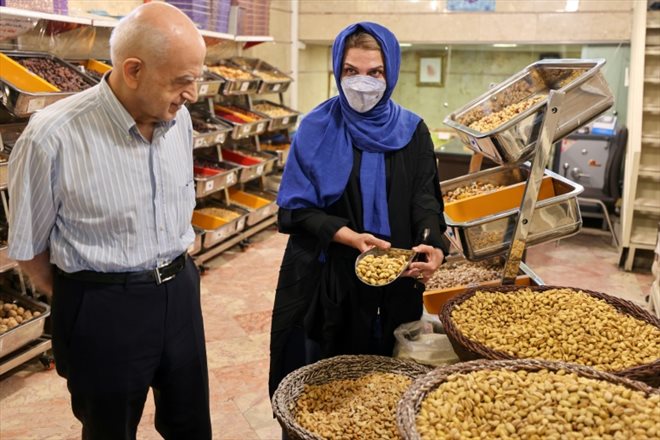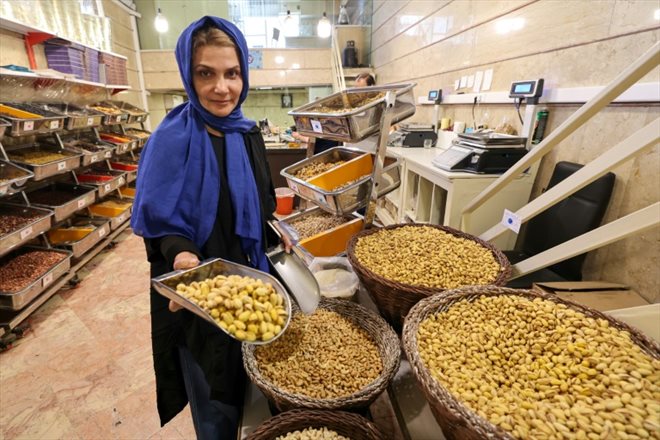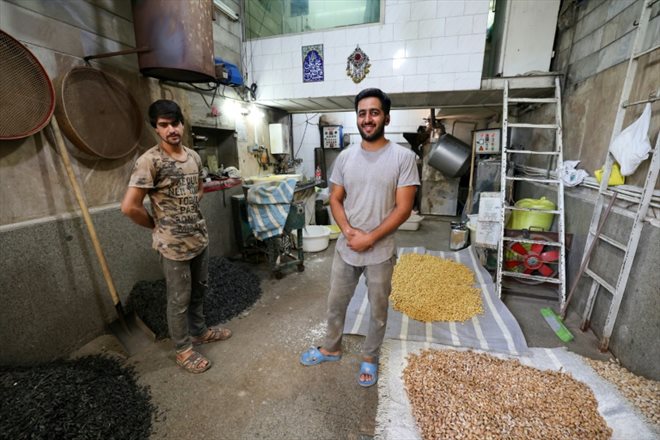Abbas Emami, 88, the oldest pistachio wholesaler in the Iranian capital, Tehran, on June 19, 2022 (AFP/ATTA KENARE)
In the heart of Tehran’s famous bazaar, the oldest pistachio wholesaler in the capital is discreetly preparing a small revolution: handing over to the youngest of his four daughters, in a country where this profession is the prerogative of men.
The 88-year-old trader goes every morning to his shop “Roasted Nuts Shams” which boasts, according to the advertisement printed on its bags, of having “more than a century of experience”.
The exact date when his family started in this business, he does not know. “My father worked in my maternal grandfather’s nut store and then left to open his own shop. I was 15 when he asked me to come and help him,” explains Abbas Emami.

Pistachios from the store of Abbas Emami, 88, the oldest wholesaler in the Iranian capital, Tehran, on June 19, 2022 (AFP/ATTA KENARE)
“During the day, I helped my father and in the evening, I studied. It took me ten years to learn all the secrets of the profession and I am gradually passing them on to my daughter”.
He first worked with his four brothers who gradually abandoned the profession. And in 1975 his father handed over the business to him.
“At the time, pistachios were reserved for the rich. During my adolescence, there were only four wholesale traders. Today there are ten times more”, he says.
– “Tricks of the trade” –
“It was in the 1950s that it became popular. Part of the population got richer and the clientele grew. I still have a hundred clients”, he adds, installed in the back room, below the black and white portrait of his father.

Abbas Emami, 88, the oldest pistachio wholesaler in the Iranian capital, Tehran, with his daughter Marjan on June 19, 2022 (AFP/ATTA KENARE)
Is he the oldest pistachio trader? This is what its competitors claim.
And it was necessary to question several of them to discover his shop wedged between a shoe store and another of belts in the district of Ahangaran.
Pistachios are grown mainly in the east of the country in Damghan and Kerman. Every two or three months, commercial agents of the growers make the rounds to take orders.
“We buy five types of pistachios. They differ in appearance, taste, size, quality and therefore price,” says Emami.

Marjan, daughter of Abbas Emami, 88, the oldest pistachio wholesaler in the Iranian capital, Tehran, on June 19, 2022 (AFP/ATTA KENARE)
“The best in terms of taste, in my opinion, is the one called Ahmad-Aghaï, which sells for 495,000 tomans ($16) per kg,” he says.
Iran is in the forefront, after Turkey and China, of consumers of this dried fruit that is offered during festivals, especially Nowruz. Each Iranian consumes an average of 330 g of pistachios per year, according to the Producers Association.
Mr. Emami teaches his daughter Marjan, 50, the secrets of the trade. “It is important to buy at the right time. You then have to put the goods in refrigerators to prevent the fruit from spoiling,” he confides.
– “Leapfrog because of the Covid” –
If he prefers to keep his know-how secret, other traders call on roasters. A few streets away in a dead end, 80 kg bags of raw pistachios are piled up.
“Once the drum has been cleaned with coarse salt, the pistachios are roasted before mixing them in a blender with salted water or saffron and then drying them,” explains Majid Ebrahimi, 31, who processes two tonnes a day.

Majid Ebrahimi (d) and a worker working at the oldest pistachio wholesaler in the Iranian capital, Tehran, on June 19, 2022 (AFP/ATTA KENARE)
According to the Ministry of Agriculture, the October harvest amounted to 280,000 tons. Half, worth 900 million dollars, was exported to 75 countries and the other is consumed in the country, indicates the association of producers.
It was the Covid-19 epidemic that convinced Marjan and her father to make up their minds. “I couldn’t come because I was both old and had heart problems. My daughter replaced me,” explains the wholesaler.
“Working here is very hard, but it’s better than staying at home,” says Marjan. “With the spread of the coronavirus, my father could not come and during the Nowruz holiday, I replaced him at the store with my two daughters”.
“Finding the goods at the right price is not easy. In addition, you also have to monitor processing, hygiene and storage,” she says.
When will he hand over to his daughter? Mr. Emami avoids answering. “You have to learn well first,” he says with a mischievous smile.
© 2022 AFP
Did you like this article ? Share it with your friends with the buttons below.




